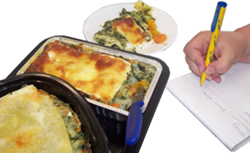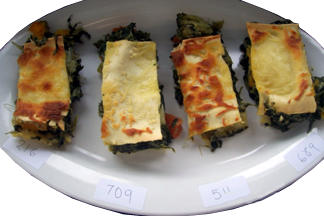Iron-enriched vegetable lasagne

Tracey Jaques
Tararua College
Year 12 Senior Technology, 14 week project
Teacher: Diana Eagle
Tracey wanted to create a product for the vegetarian market but as there are not many vegetarians in her small, rural community she loosened her constraints, focusing instead on a product for a group of teenage girls who were 'fussy' eaters.
Her survey of their likes and dislikes in main meals found that they ate a limited range of food with restricted nutritive value. She decided to develop a reheatable meal containing a selection of food from the four main food groups (vegetables and fruit, grains, dairy products, meat/meat alternatives).
Tracey researched a range of current frozen snack dinners, comparing their key attributes and properties in freezing and reheating, and got feedback from her focus group on these products. The girls weren't keen on meat but were happy to eat the macaroni cheese and vegetable cheesy bake products. This led Tracey back to her original idea – a vegetable lasagne with a cheese sauce to hide the vegetables.
As teenage vegetarians sometimes lack iron, she decided to add an iron supplement to her meal and, in consultation with a food technologist, found a supplier. She experimented with iron levels and realised that only a small amount was needed for the daily recommended intake. This information not only helped the taste of her product but also alleviated ethical concerns about using food supplements.
Tracey used a variety of sensory tests and comparative evaluations against the current market products to develop a reliable conceptual design for her product. Her focus group, and her product testing of storage, freezing, and reheating properties, ensured that the prototype was fit for its purpose in relation to reliability and optimisation.
Her lasagne vegetable bake concept was developed further so that it could be heated in the oven or microwave.
Teacher comment
Tracey drew on knowledge gained from her case study work on Meal Innovations to develop her own product concept, a HACCP, and a flow diagram of how her product would be made in multi-unit production. Throughout her project she applied this knowledge to her own work, particularly in relation to social responsibilities – legal and ethical –, ongoing production, and knowledge about current market products; this helped her practice and ensured a quality outcome.
Sensory testing with the focus group

